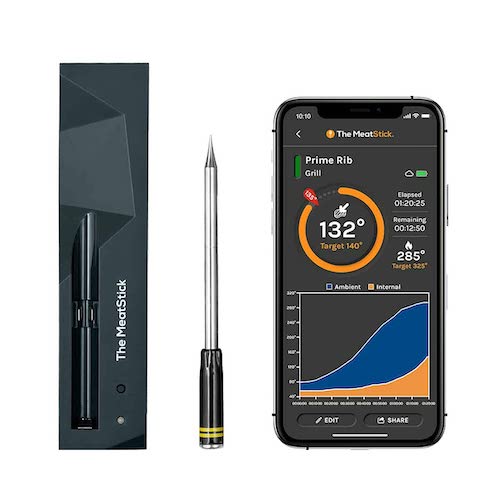Finding the best meat thermometer isn’t as easy as you might think. You need one that works well, but also looks good and is easy to use. There are hundreds of different options out there for you to choose from, so we’ve done all the hard work for you and narrowed it down to just two in this head-to-head comparison: Meatstick vs Meater!
Table of Contents
Design and Build Quality
The Meater and the Meatstick are both pretty plain, but there are some differences to note.
These two meat thermometers are almost identical, but Meater’s design is a little more refined. This makes it a bit easier to use, which is nice since you’ll be using this thermometer often.
The Meatstick has an analog dial and a larger display than the Meater, but there are some major drawbacks to having such a large display:
- The Meatstick is more accurate at reading temperatures than the Meater – both can measure within 0.5 degrees Fahrenheit (0.3 degrees Celsius), but only with their accuracy setting turned on.
- The Meatstick is also more reliable because its sensors are located inside the probe rather than along the outside like they are on the Meater.
The Meatstick has a better battery life, with an estimated life of 2 years compared to the Meater’s 1 year The Meatstick comes with a probe holder in the box (the Meater doesn’t), which makes it easy to use and store The Meatstick comes with a stainless steel probe while the Meater only comes with one made of plastic.

Both devices measure the temperature of your meat using an infrared sensor. The Meater has a black and white display that shows you the current reading, while the Meatstick has no screen at all. Instead, it relies on two audible tones: one for when it’s ready to put in your mouth and another for when it’s done cooking.

Performance and Accuracy
Although both products can be used to find the same types of meat, there are some differences that affect their performance and accuracy.
- Meatstick has a more accurate system for detecting meat while Meater is faster. The Meater app provides updates on your food’s temperature in real time, but it doesn’t provide you with as much information about the type of meat you’re cooking as Meatstick does. As such, if your goal is to cook a juicy steak or roast chicken without getting burnt on the outside or undercooked inside, then running a test with Meatstick first will give you better results than using Meater alone.
- The Meater has more features than Meatstick does: It supports up to two probes at once (Meatstick only supports one), it has a longer battery life (30 hours compared to 20 hours), and its display shows more feedback about what’s going on inside your food than Meatstick does…
- The Meater’s app is more user-friendly than Meatstick’s: It gives you more information about your food and has a simpler interface. The fact that the meat temperature update on the Meater is in real time makes it easier to monitor how well your meal is cooking without having to constantly check on it. If you’re looking for an easy-to-use tool for monitoring meat temperature and don’t care about getting precise readings of what kind of meat you’re cooking, then Meater might be better for you than Meatstick.
Connectivity and Features
The meatstick has two-way connectivity, which means you can use the app to control your device. The Meater allows you to set a temperature from your phone and get alerts when it’s reached that temperature, but it doesn’t allow you to control the device itself.
The Meater also has a wider range of temperatures—0-200°C (32-392°F) compared with 0-150°C (32-302°F). You’ll find this useful if you want to cook something like fish or pork belly, as these foods require temperatures outside of the meatstick’s range.
The Meater has a larger temperature range, which is useful if you want to cook something like fish or pork belly.
Price and Value
The Meater is obviously much more expensive than the Meatstick, but that doesn’t necessarily mean it’s better. In fact, with the Meatstick, you get a lot of value for your money. First, you have to consider how much meat sticks cost at your local market or grocery store. If you buy them in bulk and eat one every day (which we recommend), then they add up quickly! Second, there are many different types of meatsticks available on Amazon right now—including beef jerky, turkey jerky and even vegan options—and because the prices vary so much between packs it’s hard to gauge how much each individual stick costs until after you order them all together at once online through Prime Pantry or Subscribe & Save discounts (if applicable).
The Meater isn’t all bad though; it does have some benefits over traditional barbecue grilling techniques because it uses infrared technology instead of open flames which gives food an extra layer of flavor when cooking outdoors during certain seasons like summertime when temperatures rise above 90 degrees Fahrenheit but fall below 45 degrees Fahrenheit overnight which means no need for running hot water pipes through walls – which saves time installing something new into existing buildings where plumbing might already exist inside walls etcetera..
Conclusion: Which one is better?
If you’re looking for a meat thermometer that’s more accurate than the Meatstick and is more portable, then Meater is the better option. The Meater app allows you to track your grilling process from anywhere in the world, so you can get updates on your grill even if it’s not under your nose.
If you have a large family or just like making meat-heavy meals, then Meatstick will be better for cooking multiple steaks or burgers at once. You don’t need to use any wires with this device because it uses Bluetooth technology instead of Wi-Fi which means there’s less risk of getting disconnected from the app while grilling!
Both are great products but if we had to choose between them…we’d go with Meatstick because it has a wider variety of features such as being able to keep track of how many burgers have been cooked already during today’s barbecue party.
See also:

Hi, I’m Jen from New Mexico. I have been working from home as a graphic designer for a long time. While working at home, I realized that I enjoy spending time in the kitchen. The kitchen is my biggest hobby. I set up this site to relay the products and experiences I’ve tried. I review many kitchen equipment and share them with you!
